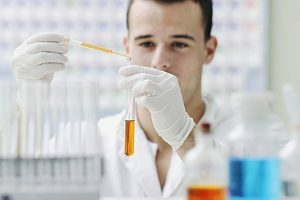Renal microlithiasis often passes unnoticed for the patient. This pathology is characterized by the accumulation of various salts in the renal pelvis. At its core, the disease is the initial stage of urolithic education. In the pelvis there are small tumors that do not exceed a few millimeters in diameter.

Pathology proceeds without obvious signs. There is a small number of symptoms that can be suspected of urolithiasis. Also, the disease does not depend on the sex and age characteristics of the patient. It can develop at any age. The causes of microlithiasis are also diverse. For this reason, it is recommended that ultrasound examination of the kidney be performed annually. When they are examined, there may be a presence of a suspension or plaques in the pelvis.
Do not treat pathology with disdain. Microlithiasis is accompanied by further growth of stones. This can lead to surgery. If untimely access to a specialist, a fatal outcome may occur.
Characteristics of the process
Microlithiasis is accompanied by accumulation of several small stones in the kidneys. The etiology of the stones is diverse. The composition of microliths can include phosphate acid, oxalic or uric. These acids accumulate in the pelvis and react with calcium salts. Suspended in the urine. The development of the process is accompanied by subsidence of the suspension in the kidneys. It clings to the epithelial layer of the inner surface of the kidney. When several flakes are superimposed, a small flat new formation is formed, a microlite. Such particles in the kidney may be several.
Oxalates are considered common microliths. Oxalate stones are a very unpleasant problem for the kidneys. This is due to the peculiarity of their structure.
Oxalates have a knobby surface. The tops of the tubercles have a sharpening. When moving such a stone in the kidneys can appear wound. The epithelial layer begins to heal. As in the kidneys the process develops further, the wound surface becomes inflamed. A complication is added to the urolithiasis.
There are also phosphate and urate stones. These tumors have a flat surface and a dark color. The structure of these stones is more dense. This causes the main complication in their removal. To eliminate pathology in many cases, early medical intervention is required. If you miss the stage of microlithiasis, then the patient needs to perform surgery.
Negative factors causing the formation of stone
The reasons for the accumulation of acids in the kidneys are different. The main pathological processes are the following:
-
 Incorrect selection of nutrition;
Incorrect selection of nutrition; - Having bad habits;
- Trauma of the lumbar region;
- Patient's heredity;
- Prolonged absence of liquid;
- The high content of vitamins of group C and calcium in products.
The main negative effect on stone formation is food. People have a varied diet. If the food contains a large amount of calcium and various acids, the process of formation of microliths is enhanced. Such products include many cereals and legumes. Also, the formation of stones is enhanced by the intake of fruit acids. Sin them with a lot of oranges. The constant consumption of food that provokes microlithiasis causes a worsening of the course of the disease. The process intensifies, the stones expand.
Another dangerous reason is the use of alcoholic beverages. The increase in stone formation is mainly a foam drink, loved by many men. Beer contains herbal extracts, which increase diuresis, but provoke the accumulation of decomposition products in the kidneys. Long-term abuse of a beer drink is accompanied by the appearance of small stones in the kidneys. This process is called microlithiasis.
Obtaining injuries of the lumbar region can be accompanied by a violation of the basic functions of the kidneys. Some injuries of the lower back cause a change in the structure of the kidney tissue. This is due to the inflammatory process. Inflammation leads to impaired absorption of the papillae of the epithelium. It ceases to remove acids and various substances of finite cleavage. A variety of acids accumulate in the pelvis. In such patients, microliths of various etiologies may form in the kidneys. This phenomenon significantly complicates the selection of necessary therapy.
It was found that many patients with kidney microlithiasis have relatives of patients with the same disease. This is due to the genetic predisposition of the patient to stone formation. This group of patients is recommended to visit the medical center at least once every six months. If visits are rare, the risk of pathology increases. Timely therapy in this case will not be provided.
Also, microlithiasis of the renal pelvis is observed with severe dehydration of the patient. Absence of water entails absorption of all liquids accessible to the body. Initially, water loss occurs in the pelvis. The removal of moisture is accompanied by the preservation of calcium salts in the kidneys.
 Salts are retained until normalization of water intake. When water gets from various fruits or foods in the body, the formation of acids increases. In the kidneys, the acid reacts with the salt. There is a kidney stone disease. The same mechanism is observed in patients with diabetes mellitus. Diabetics do not have normal trophic nutrition of tissues. The fluid is drawn from the available tissues. In the treatment of diabetes, the patient is necessarily examined for microlithiasis.
Salts are retained until normalization of water intake. When water gets from various fruits or foods in the body, the formation of acids increases. In the kidneys, the acid reacts with the salt. There is a kidney stone disease. The same mechanism is observed in patients with diabetes mellitus. Diabetics do not have normal trophic nutrition of tissues. The fluid is drawn from the available tissues. In the treatment of diabetes, the patient is necessarily examined for microlithiasis.
Urolithiasis also depends on the patient's lifestyle. If a person leads a sedentary lifestyle and is in a long time in one position, stagnation occurs in the pelvic organs. With a long stay in one place, the activity of all organs and tissues decreases. Stagnation is accompanied by the accumulation of a large number of acids in the kidneys. If the patient does not normalize vital functions, after a while he will be diagnosed with microlithiasis.
Symptoms of pathology
Microlithiasis does not have a pronounced symptomatology. The patient does not notice any changes in the work of the body. There are a number of secondary symptoms that can be used to diagnose kidney pathology:
- Lumbar pain in an unusual posture;
- Increase in body temperature;
- Changing the qualitative composition of urine;
- Severe swelling of the lower limbs.
All these signs are not permanent. Soreness often accompanies an unusual position of the body. Patients do not pay attention to this symptom. In many cases of microlithiasis, a specialist is later consulted. This causes difficulties in the choice of rational treatment. Also often men come to the hospital with a stone stuck in the renal duct or ureter. If you seek advice at the stage of microlithiasis, you can avoid an unpleasant complication.
Diagnosis and treatment
Therapy of microlithiasis is carried out only after passing the diagnosis. Specialists use an ultrasonic device to detect microliths. But it helps to accurately determine the size of the stones and their localization. After determining the nature of the urolithic process, treatment is prescribed. Therapy of microlithiasis should be accompanied by maintenance of a certain diet and rest. Only a strict observance of these rules causes the rapid destruction of microliths.
Self-medication in this pathology should not be dealt with. The characteristics of the stones are different. It can be determined only after the urine has been tested. After determining the type of stones, a therapy is selected, which will quickly eliminate microlithiasis of the kidneys.



